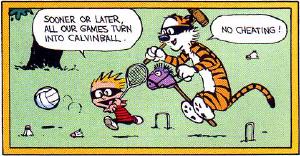Blog
Calvinball
15 September 2014
 Bill Watterson
Bill WattersonIn Bill Watterson’s comic strip Calvin and Hobbes, there is a game known as Calvinball. The basic idea of Calvinball is that rules are added by players as the game progresses. Players can add to the rules as you go along, but once a rule is in place it can’t be undone. The result is a hodge-podge game where the action is incomprehensible by anyone but the participants. Often in popular science quantum theory is portrayed as the physics version of Calvinball, even though that isn’t how quantum theory works. Quantum objects may be strange, but they aren’t making up rules as the universe plays on.
A good example of this can be seen in the double slit experiment. The basic setup of the experiment is that you shine a beam of something (light, electrons, etc.) at a barrier with two small openings. Ideally the beam is free to pass through the openings, but is completely blocked by the barrier. You then set up a screen or detector array behind the barrier and see what happens. The experiment is seen as the classic test of whether quantum objects are particles or waves. If they are particles, then the detector should detect the beam only at two local regions (where the beam passed through the openings like a baseball through a gap in a fence). If they are waves, then the detector should see an interference pattern, since the waves passing through each opening interfere with each other.
The double slit story is usually told about electrons. Early experiments with electron beams clearly demonstrated that electrons are particles. But when you put an electron beam through a double slit, the detectors observe an interference pattern. New rule! It seems odd that particles would do such a thing, so suppose you put a secondary detector over each slit to see which opening each electron goes through. When this experiment is done the interference pattern goes away, and the electrons are only seen in two local regions. New rule! So suppose you detect which slit each electron goes through, but then destroy that information before you check the pattern. Do this and the interference pattern comes back. New rule! And on and on.
Because of the way the double slit story is told, it seems as if the electron beam knows what experimenter is doing, and knowingly changes the outcome. The most popular video on YouTube concerning the double slit experiment (from the pseudoscience movie What the Bleep Do We Know?) actually states this. The electrons know when they are being watched, and therefore conscious observation affects the outcome of the experiment.
But this isn’t what the double slit experiment actually shows. What it shows is that quantum objects such as electrons are neither particles nor waves. They have particle-like properties and wave-like properties, but their true physical nature can be seen in the mathematical formalism of quantum field theory, where you don’t distinguish between particles and waves. When we set up an experiment to study their particle properties, quantum objects appear as particles. When we study wave properties, we see waves. It isn’t that mysterious when you recognize that quantum objects are simply quantum objects.
That doesn’t mean quantum objects aren’t strange. They are very strange, and it can be difficult for our particle/wave focused minds to really understand them. But that strangeness hasn’t prevented us from building quantum theory in to the most precise scientific model ever devised.
So instead of Calvinball, quantum theory is more like a game of Go, where the rules are very clear, but truly understanding how they are applied can take a lifetime of study.